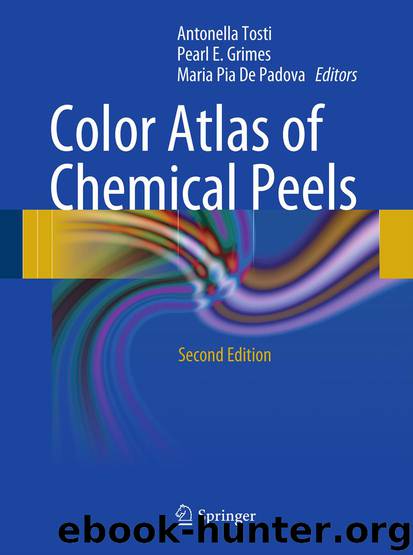Color Atlas of Chemical Peels by Antonella Tosti Pearl E. Grimes & Maria Pia De Padova

Author:Antonella Tosti, Pearl E. Grimes & Maria Pia De Padova
Language: eng
Format: epub
Publisher: Springer Berlin Heidelberg, Berlin, Heidelberg
Trichloroacetic acid and phenol peels (see peel sections) have been used extensively to treat photodamage [86, 87]. However, TCA peels in concentrations above 35% are unpredictable. Albeit efficacious for severe photodamage, phenol peels are associated with myriad side effects [87]. Hence, combination medium-depth peeling agents have become increasingly popular for treatment of photodamage. Monheit and Coleman [88, 89] popularized the concept of combination peeling procedures using Jessner’s solution or glycolic acid in combination with TCA 35%. The application of Jessner’s solution prior to TCA peeling was effective in destroying the epidermal barrier allowing for deeper penetration and more even application of the TCA peel. Similar results are achieved with application of 70% glycolic acid prior to TCA peeling. Tse et al. [90] in a split-face study of 13 patients with photodamage compared the efficacy of 70% glycolic acid and TCA 35% to Jessner’s solution and TCA 35%. Clinical and histological assessments were performed at 7, 30, and 60 days after peeling. Clinically, the glycolic acid/TCA 35% peel was more effective for the treatment of actinic keratoses. It induced a slightly thicker Grenz zone, greater papillary dermal fibrosis, and neovascularization compared to Jessner’s solution/TCA 35% (Figs. 14.4–14.7).
Samaby et al. [91] performed medium-depth peeling using 70% glycolic acid and 35% TCA in 5 patients with facial photodamage. Biopsies were performed at baseline, prior to chemical peeling, and at 3 months following the peel. Histological and ultrastructural assessments showed markedly decreased epidermal intracytoplasmic vacuoles, decreased elastic fibers, increased activated fibroblasts, and organized arrays of collagen fibrils suggesting that a combination medium-depth glycolic acid 70%/TCA 35% peel improves photodamage. These findings were confirmed by Sezer and colleagues, who found that glycolic acid 70%/TCA 35% gave results comparable to those achieved with cryotherapy [92]. They found that the peel was less painful and carried a lower risk of postprocedural hyperpigmentation than cryotherapy, although it was more time consuming.
Lawrence et al. [93], in a split-face study, compared the efficacy and safety of Jessner’s solution and 35% TCA to 5% fluorouracil in the treatment of widespread facial actinic keratoses. Fifteen patients were treated. Both treatments reduced the number of visible actinic keratoses by 75%. Similarly, both caused equivalent reductions in keratinocyte atypia, hyperkeratosis, and parakeratosis. Compared to fluorouracil, only one application of the peel was necessary.
Pyruvic acid peels have also been used for treatment of photodamage. Pyruvic acid is an α-keto acid which is converted physiologically to lactic acid. It is used in concentrations of 40–70% in water/ethanol solutions. Ghersetich et al. [94] treated 20 patients with Glogau’s photoaging types I and II. A series of 4 peels were performed at 4 week intervals. After pyruvic acid peeling, subjects demonstrated a smoother texture, less evident fine wrinkles, and lightening of areas of hyperpigmentation. Side effects were minimal. A modified 50% pyruvic acid peel, containing dimethyl isosorbide, propylene glycol, ethyl alcohol, dimethyl sulfone, ethyl lactate and water, has been used by Berardesca et al. in patients with photodamage, superficial scarring, and melasma. The treatment produced significant improvements in
Download
This site does not store any files on its server. We only index and link to content provided by other sites. Please contact the content providers to delete copyright contents if any and email us, we'll remove relevant links or contents immediately.
| Administration & Medicine Economics | Allied Health Professions |
| Basic Sciences | Dentistry |
| History | Medical Informatics |
| Medicine | Nursing |
| Pharmacology | Psychology |
| Research | Veterinary Medicine |
Periodization Training for Sports by Tudor Bompa(7929)
Why We Sleep: Unlocking the Power of Sleep and Dreams by Matthew Walker(6366)
Paper Towns by Green John(4808)
The Immortal Life of Henrietta Lacks by Rebecca Skloot(4264)
The Sports Rules Book by Human Kinetics(4081)
Dynamic Alignment Through Imagery by Eric Franklin(3925)
ACSM's Complete Guide to Fitness & Health by ACSM(3827)
Kaplan MCAT Organic Chemistry Review: Created for MCAT 2015 (Kaplan Test Prep) by Kaplan(3805)
Introduction to Kinesiology by Shirl J. Hoffman(3629)
Livewired by David Eagleman(3535)
The River of Consciousness by Oliver Sacks(3421)
The Death of the Heart by Elizabeth Bowen(3344)
Alchemy and Alchemists by C. J. S. Thompson(3300)
Descartes' Error by Antonio Damasio(3168)
Bad Pharma by Ben Goldacre(3107)
The Emperor of All Maladies: A Biography of Cancer by Siddhartha Mukherjee(2934)
The Gene: An Intimate History by Siddhartha Mukherjee(2929)
The Fate of Rome: Climate, Disease, and the End of an Empire (The Princeton History of the Ancient World) by Kyle Harper(2878)
Kaplan MCAT Behavioral Sciences Review: Created for MCAT 2015 (Kaplan Test Prep) by Kaplan(2823)
